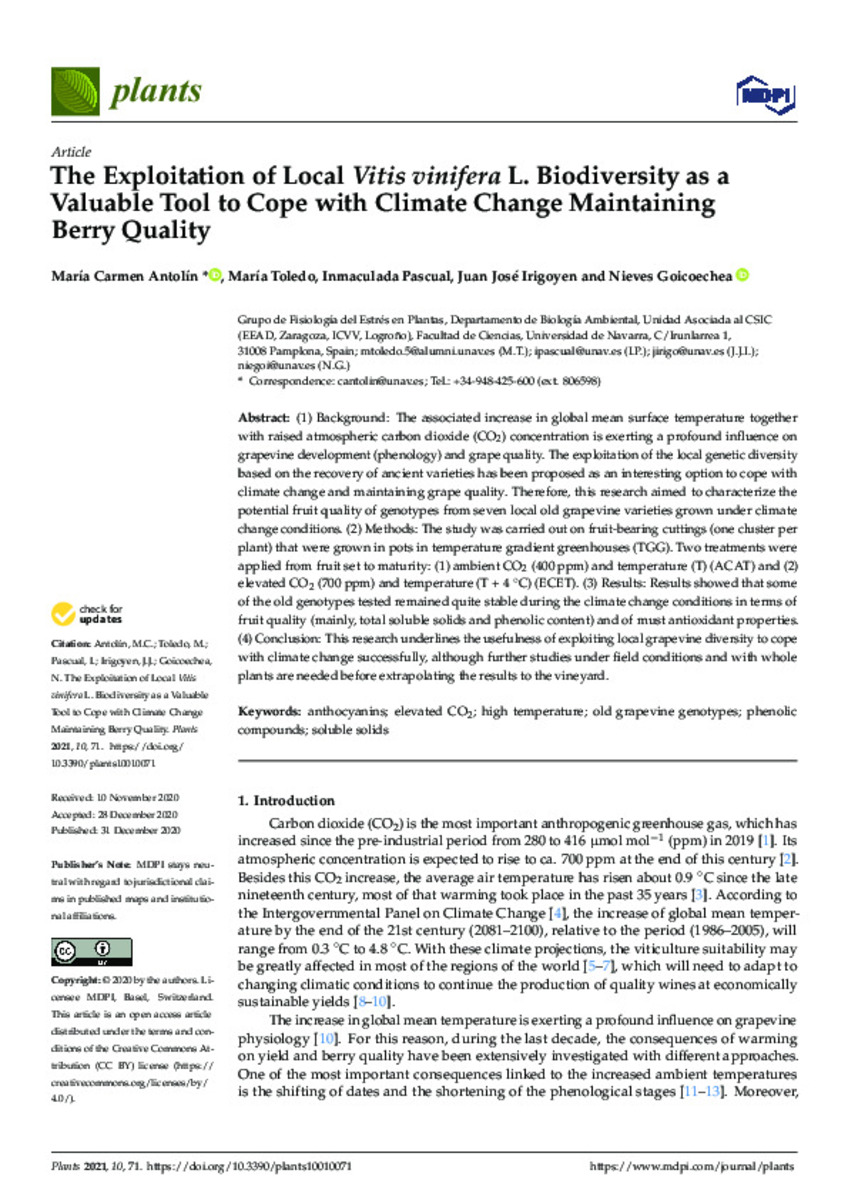Full metadata record
| DC Field | Value | Language |
|---|---|---|
| dc.creator | Antolin-Bellver, M.C. (M. Carmen) | - |
| dc.creator | Toledo, M. (María) | - |
| dc.creator | Pascual, I. (Inmaculada) | - |
| dc.creator | Irigoyen, J.J. (Juan Jose) | - |
| dc.creator | Goicoechea, N. (Nieves) | - |
| dc.date.accessioned | 2023-12-18T08:23:56Z | - |
| dc.date.available | 2023-12-18T08:23:56Z | - |
| dc.date.issued | 2020-12-31 | - |
| dc.identifier.citation | Antolín, M.C.; Toledo, M.; Pascual, I.; Irigoyen, J.J.; Goicoechea, N. The Exploitation of Local Vitis vinifera L. Biodiversity as a Valuable Tool to Cope with Climate Change Maintaining Berry Quality. Plants 2021, 10, 71. https://doi.org/ 10.3390/plants10010071 | es_ES |
| dc.identifier.issn | 2223-7747 | - |
| dc.identifier.uri | https://hdl.handle.net/10171/68068 | - |
| dc.description.abstract | The associated increase in global mean surface temperature together with raised atmospheric carbon dioxide (CO2 ) concentration is exerting a profound influence on grapevine development (phenology) and grape quality. The exploitation of the local genetic diversity based on the recovery of ancient varieties has been proposed as an interesting option to cope with climate change and maintaining grape quality. Therefore, this research aimed to characterize the potential fruit quality of genotypes from seven local old grapevine varieties grown under climate change conditions. (2) Methods: The study was carried out on fruit-bearing cuttings (one cluster per plant) that were grown in pots in temperature gradient greenhouses (TGG). Two treatments were applied from fruit set to maturity: (1) ambient CO2 (400 ppm) and temperature (T) (ACAT) and (2) elevated CO2 (700 ppm) and temperature (T + 4 ◦C) (ECET). (3) Results: Results showed that some of the old genotypes tested remained quite stable during the climate change conditions in terms of fruit quality (mainly, total soluble solids and phenolic content) and of must antioxidant properties. (4) Conclusion: This research underlines the usefulness of exploiting local grapevine diversity to cope with climate change successfully, although further studies under field conditions and with whole plants are needed before extrapolating the results to the vineyard. | es_ES |
| dc.language.iso | eng | es_ES |
| dc.relation | This research was funded by Fundación Universitaria De Navarra (2018) | es_ES |
| dc.rights | info:eu-repo/semantics/openAccess | es_ES |
| dc.subject | Anthocyanins | es_ES |
| dc.subject | Elevated CO2 | es_ES |
| dc.subject | High temperature | es_ES |
| dc.subject | Old grapevine genotypes | es_ES |
| dc.subject | Phenolic compounds | es_ES |
| dc.subject | Soluble solids | es_ES |
| dc.subject | Materias Investigacion::Ciencias de la vida::Biología | es_ES |
| dc.title | The exploitation of local vitis vinifera L. biodiversity as a valuable tool to cope with climate change maintaining berry quality | es_ES |
| dc.type | info:eu-repo/semantics/article | es_ES |
| dc.editorial.note | CC BY 4.0. | es_ES |
| dc.identifier.doi | 10.3390/plants10010071 | - |
Files in This Item:
Statistics and impact
Items in Dadun are protected by copyright, with all rights reserved, unless otherwise indicated.






